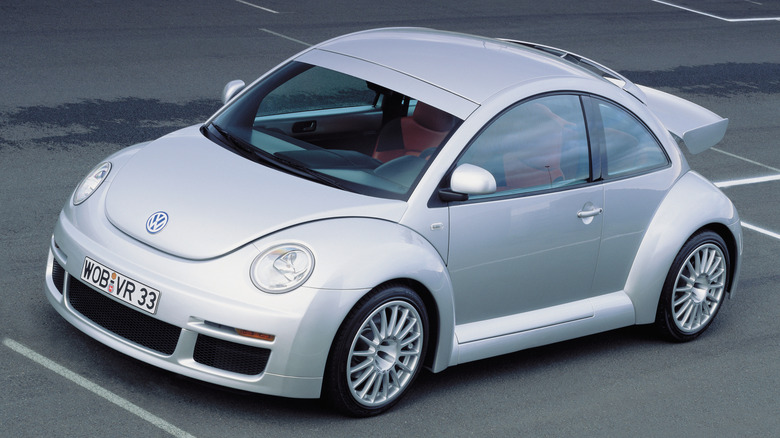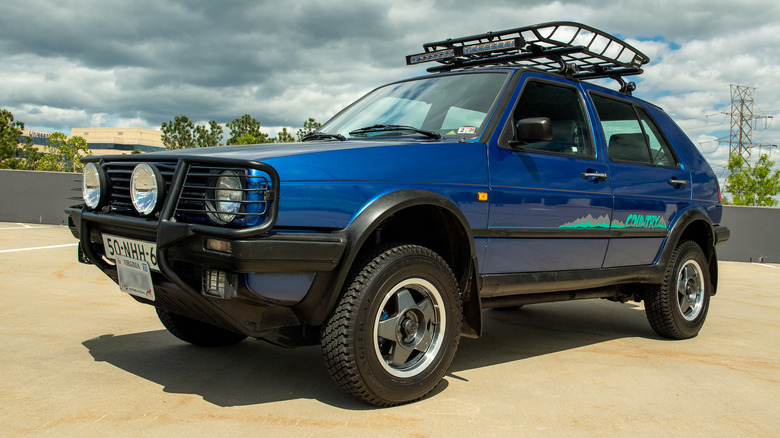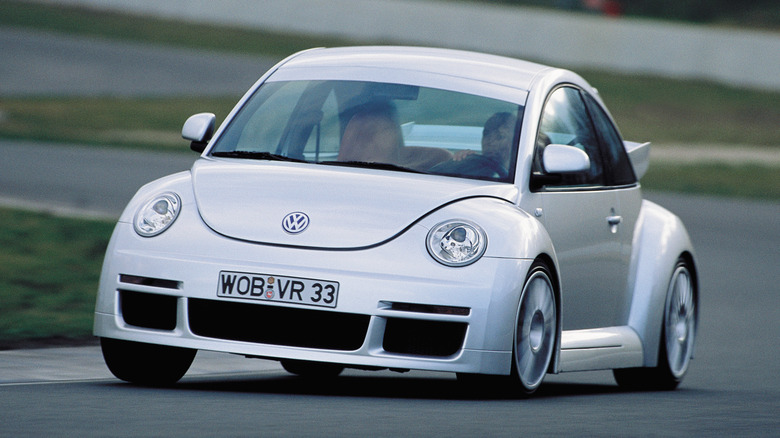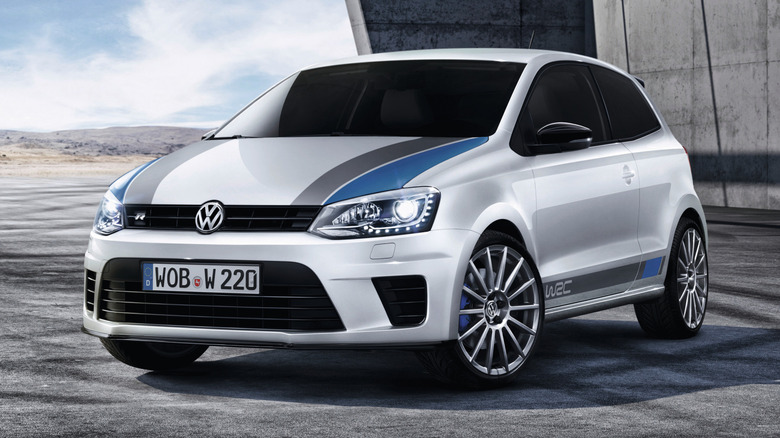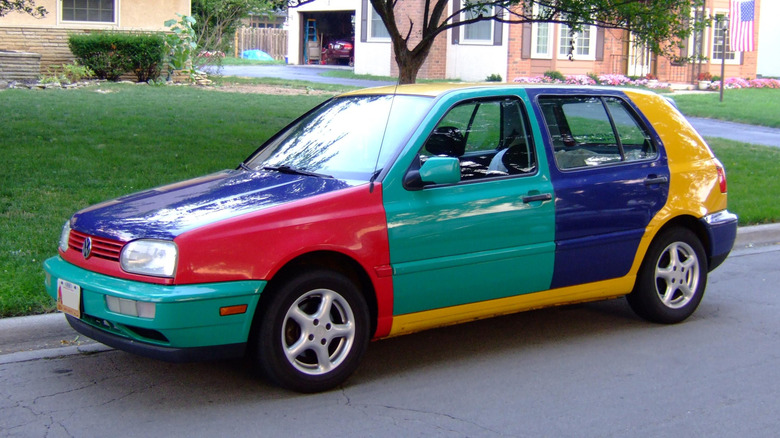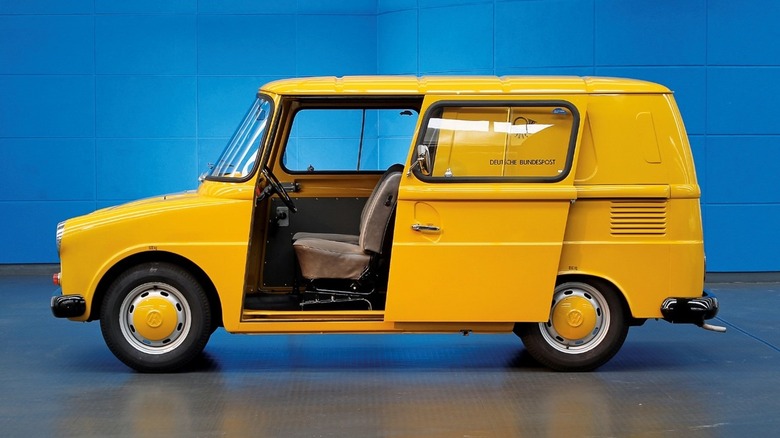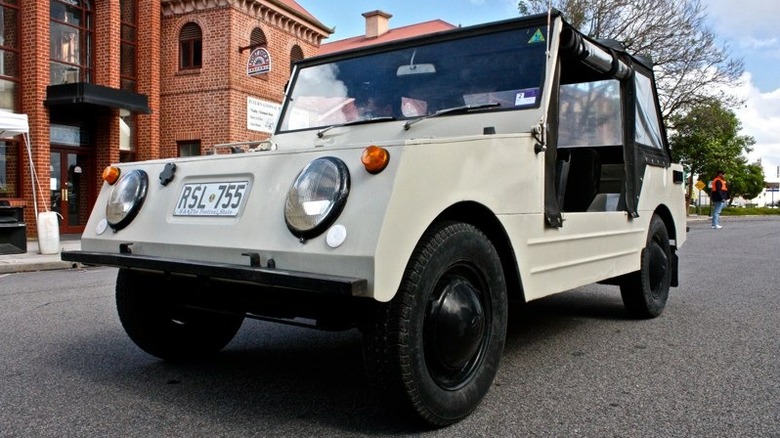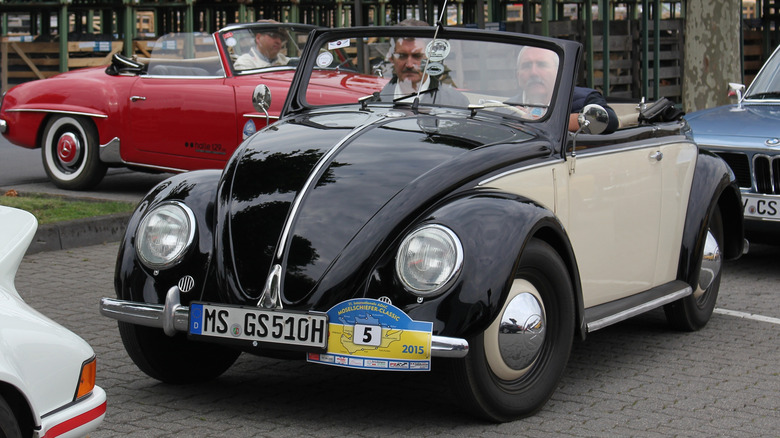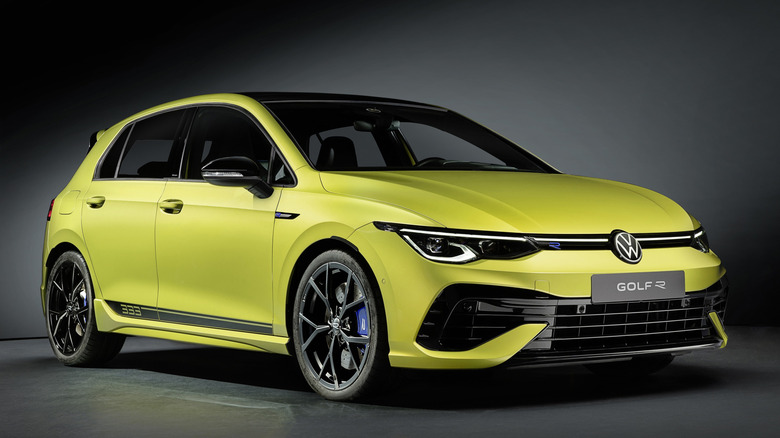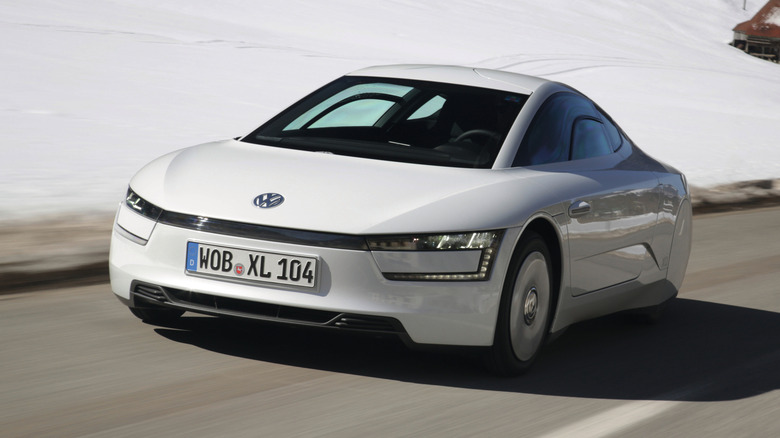10 Of The Rarest Volkswagen Models Ever Made
From its roots in wartime Germany to its expansion into one of the world's biggest automakers, Volkswagen's success has been built on the back of its most popular models. The Beetle, Golf, and in more recent years, models like the Tiguan, have all helped the automaker establish a firm presence in every major global automotive market. Many of its well-known nameplates have total production figures in seven or eight-digit territory, but like any major automaker, Volkswagen has its fair share of lesser-known models that many enthusiasts might have never even heard of.
From stripped-out homologation specials to helmet-shaped diesel hybrids, the range of rare models in Volkswagen's back catalog is a varied one. These 10 models are among the rarest of all, each being highly sought after among collectors and a real rarity to see in the metal. Most were only ever sold in one country, although a few examples have since been imported to other parts of the world.
Volkswagen Golf Country
One of the rarest variants of the Volkswagen Golf was never meant to be built; instead, it was intended to stay as a concept. The Volkswagen Golf Country took elements of SUV design and applied them to the Mk2 Golf, resulting in not only a car that looked unique, but one with some unique talents. It was fundamentally still a Golf underneath, specifically a Golf Syncro, which was built at Volkswagen's main factory before being sent to Steyr-Daimler-Puch, the makers of the Mercedes G-Wagon, for conversion into Golf Country spec. Thanks to its unique overhaul, it was also a genuinely capable off-roader.
Per Volkswagen, the conversion involved 438 new parts, transforming the car with a near-five-inch lift, off-road suspension, underbody skid plates, and bull bars. Despite being significantly heavier than the standard Golf as a result of this transformation, VW didn't offer any performance boost for the Golf Country. That meant it was slower and its handling was less sharp than a standard Golf, but on the flip side, it also meant that the Golf Country could go places that no standard Golf would ever be able to. A total of 7,735 examples of the car were built, although none were ever sold officially in America. In the decades since its launch, a few examples have been known to have been imported Stateside, but they still remain extremely rare.
Volkswagen Beetle RSi
The New Beetle might seem like an obvious starting point for an ultra-limited, race-derived homologation special, but that didn't deter Volkswagen. Only 250 examples of the Beetle RSi were ever built, all of which were made in the brand's former Beetle plant in Mexico. The RSi was no simple appearance package — it featured a unique wide body, an all-wheel drive system, and a 3.2-liter VR6 engine churning out 221 horsepower. Connecting the latter two was a six-speed manual transmission.
The car wasn't built out of necessity, as the racing Beetles from which it takes design inspiration were already subject to their own unique series. It was built simply because Volkswagen wanted to show off the Beetle's versatility while also presumably generating extra column inches in enthusiast magazines with a view to shifting more examples of the standard car. Today, it remains a sought-after collector's car among those in the know, and on the rare occasion one appears for sale, it commands prices of around $70,000.
Volkswagen Polo R WRC
While VW didn't strictly need to make the Beetle RSi, it did need to produce the Polo R WRC to get its competition-spec car approved for the World Rally Championship. The automaker built 2,500 examples of the car, the exact minimum required to pass homologation. Under its hood sat a 217 horsepower turbocharged 2.0-liter four-cylinder engine, with power sent to the ground through a six-speed manual transmission. At the time, the Polo R WRC was the most powerful Polo ever put into production.
In addition to the powertrain upgrades, VW also upgraded the car's suspension, brakes, and tires. Unlike the Beetle RSi, it didn't feature an attention-grabbing wide body kit or rally-style aero, and aside from the unique decals, it might not even be clear at first glance that the Polo is one of the rarest Volkswagens around. However, the competition-spec rally Polo made much more of a lasting impression than its ultra-limited homologation counterpart. It racked up a staggering 43 wins between 2013 and 2016, the highest tally of any car in World Rally Championship history.
Volkswagen Golf Harlequin
The colorful Polo Harlequin is one of Volkswagen's special edition success stories, selling over 3,000 examples, more than three times the automaker's original estimate. It turned out that European buyers couldn't get enough of the distinctive Polo, and so Volkswagen tried to replicate its success in America. Since the Polo wasn't sold in the U.S., the brand decided to use the Golf as the base for a Harlequin model instead. It built a one-off example to show off at auto shows, then instructed its Mexican plant to build an initial batch of 264 examples.
It turned out that American buyers weren't as sold on the multi-color paint scheme as the European market, and even the initial production run struggled to sell. After a while, some VW dealers even reportedly rebuilt their Golf Harlequins to turn them into standard, one-color models. A few original examples are known to still survive, with a small but dedicated community of North American enthusiasts keeping them on the road.
Even though the American-market Golf Harlequin didn't sell as well as Volkswagen had hoped, the automaker continued to produce low-volume special editions of the Mk3 Golf for other markets. In Europe, Volkswagen sold a trio of music-themed specials centered around Pink Floyd, the Rolling Stones, and Bon Jovi, each of which was designed to commemorate the European tours of its respective bands.
[Featured image by Analogue Kid via Wikimedia Commons | Cropped and scaled | CC BY-SA 3.0]
Volkswagen Fridolin
The Type 147 Kleinlieferwagen, more commonly called the Fridolin, looks like a mashup of other Volkswagen models merged together into one unusually shaped vehicle. That's no coincidence — in fact, it's exactly how the Fridolin was originally created. Germany's postal service had asked Volkswagen to custom build a post van in the '60s, and requested that it feature dual sliding doors and a compact size. Rather than adapt the Type 2 bus, Volkswagen instead used the smaller Karmann Ghia's chassis as a starting point, borrowing a powertrain from the Beetle and a front fascia from the Type 3. Since the car still needed to transport plenty of cargo, the automaker grafted on the rear end of the Type 2.
The result was a completely unique minivan with an impressive cargo capacity for its size, yet an affordable price tag thanks to its shared components. The postal service was impressed, and ordered an initial batch of examples in 1964. Shortly after, the Swiss postal service saw the van that their German counterparts were using and asked Volkswagen for their own.
The Swiss Fridolin featured extensive modifications at the postal service's request, and it's the rarer model of the two. Around 5,000 German-spec examples of the Fridolin were built over a decade-long production run, plus roughly 1,000 examples of the Swiss-spec version. Only a small handful of those exist today.
Volkswagen SP2
Volkswagen has a long production history in Brazil and has built several models specifically for the Brazilian market. One of the rarest is the SP2, a sports car with sleek looks but a humble powertrain. The car was an evolution of the SP1, which borrowed the engine and chassis of the Type 3 but featured all-new bodywork inspired by European exotics. The trouble was that it was unacceptably slow, with just 65 horsepower on tap. The revised SP2 kept the same unique looks and added an extra ten horsepower, which was evidently enough to convince a small number of Brazilian buyers.
It's thought that around 10,000-11,000 examples were built in total, the vast majority of which were sold in Brazil. According to Bonhams, around 680 examples of the car were exported, ending up in dealerships in a wide variety of countries across Latin America and further afield. Volkswagen even sent 155 examples to its Nigerian dealerships. The few surviving examples left today are sought after by collectors and can command prices in excess of $40,000.
Volkswagen Country Buggy
Another obscure local market special, the Volkswagen Country Buggy was designed and built by the automaker's Australian division.It used a Beetle chassis and engine and was designed as a beach-friendly alternative to the brand's best-selling car. It was in essence, the Aussie counterpart to The Thing, which has become a cult classic in its own right in America. However, the Country Buggy is significantly rarer than The Thing, with only 1,952 examples built in Australia before production ended.
Buyers weren't interested in the ultra-basic buggy, which didn't feature doors or windows. By the time Volkswagen ended production, it had amassed an inventory of part-assembled vehicles that it couldn't sell and eventually shipped them to the Philippines. There, the buggy proved more popular with buyers, and its design even lived on with a new Type 181 chassis after the original remaining kits were sold. The Country Buggy was later adapted to become the Sakbayan, a domestically produced model in the Philippines' then-fledgling car industry.
[Featured image by Ferenghi via Wikimedia Commons | Cropped and scaled | CC BY 3.0]
Volkswagen Hebmüller Cabriolet
An open-top variant of the original Volkswagen, the Hebmüller Cabriolet debuted in 1949. German industry was still rebuilding after the war, with the Hebmüller Cabriolet, also known as the Type 14A, being one of the period's first "luxury" vehicles. Luxury is a relative term here — with its meager 24.5 horsepower engine, it was far from a true weekend cruiser.
However, it featured extras like a glove box, an integrated clock, and a distinctive convertible roof, making it stand out from other domestic offerings at the time. Originally, a run of 2,000 examples were planned to be built, but a factory fire halted production after 696 examples had found buyers. Hebmüller, the German coachbuilder tasked with manufacturing the car, couldn't financially recover from the fire, and production never restarted. Only a few examples of the Hebmüller Cabriolet, mostly in the hands of dedicated German enthusiasts.
[Featured image by Lothar Spurzem via Wikimedia Commons | Cropped and scaled | CC BY-SA 2.0]
Volkswagen Golf R 333 Limited Edition
As some readers likely learned during childhood, three is a magic number. Perhaps Volkswagen's engineers had been listening to the popular song when they created the Golf R 333, an ultra-limited version of the all-wheel drive hot hatch with more power and unique suspension. The car was limited to 333 examples and featured an uprated version of the regular Golf R's engine, with 333 metric horsepower on offer. Each example of the car was finished in the same shade of Lime Yellow Metallic and featured an Akrapovič exhaust just in case its paint wasn't already loud enough.
Volkswagen upped the car's speed limiter to 167 mph and included a dedicated drift and "special" driving mode, which it claimed had been specially designed for the Nürburgring. The car was only ever sold in Germany and retailed for 76,410 euros, around $83,000 at the time of its launch in 2023.
Volkswagen XL1
It's undoubtedly one of the weirdest-looking cars of its era, but there's a good reason the Volkswagen XL1 looks the way that it does. It's all to do with efficiency — Volkswagen built the car to be the most efficient diesel hybrid in the world, and so it needed to be as aerodynamically slippery as possible. Its engine also needed to be exceptionally frugal, so the automaker designed and built a unique two-cylinder TDI diesel powertrain for the car. The result was an official fuel consumption rating of 0.9 liters/100 kilometers, which equates to around 261 mpg.
Despite looking like a one-off concept and featuring the kind of pioneering technology usually reserved for engineering prototypes, the XL1 was actually put into limited production. Volkswagen reportedly built 250 examples of the car in total and sold 200 of them to buyers around the world. Despite having a six-figure price tag, the XL1 quickly sold out after order books opened. Although resale values have dipped since then, they still command significant prices when they appear for sale, with one example selling for around $90,000 in late 2024.
